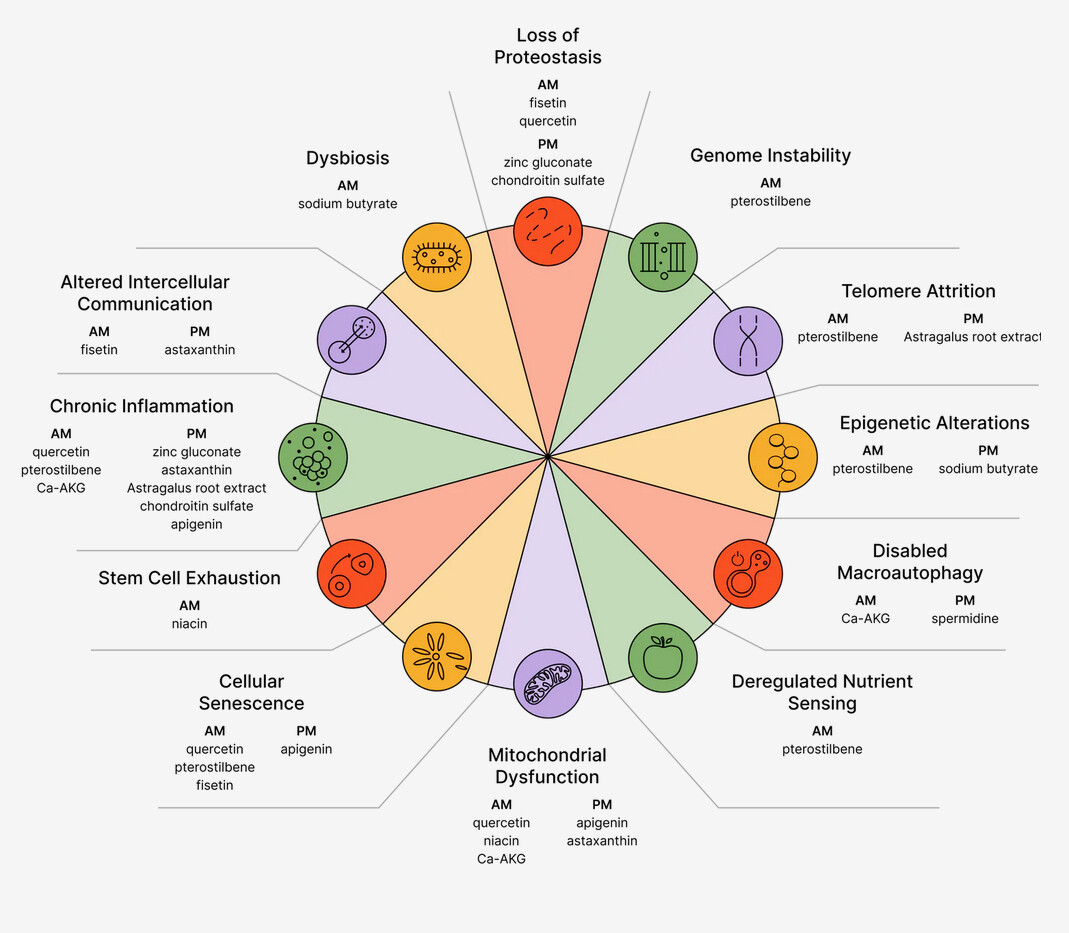Another interesting graphic to go with those above. From - https://www.vitadao.com/blog-article/rapamycin-is-the-most-promising-aging-intervention-we-currently-have
Rapamycin positively influences all hallmarks of aging
One of the most influential papers in the field of aging is a 2013 review titled “ The Hallmarks of Aging”. Here 9 hallmarks are attributed to aging, such as telomere attrition, epigenetic alterations, genomic instability, and others. Rapamycin influences all of them.
mTOR is an enzyme belonging to the class of kinases. Kinases work by adding phosphate groups to their substrates, which can cause conformational changes to the protein structure to regulate their function.
Rapamycin does not inhibit mTOR directly, but rather by forming a complex with a protein from the class of immunophilins called FKBP12. The resulting complex in turn binds mTOR and inhibits it allosterically. Allosteric inhibition means that the inhibitor slows down the enzyme, mTOR, without blocking its active site. The advantage of this mechanism is that rapamycin is highly specific to mTOR, compared to inhibitors that block the kinase function at the active site of mTOR directly, which tend to inhibit other kinases as well.
mTOR is a master regulator of nutrient sensing and growth signaling
The mTOR complexes are the main signaling nodes integrating environmental signals into cellular responses. If the conditions are favorable for anabolic processes, the mTOR pathway will initiate growth and proliferation.
To facilitate this, mTORC1 responds to nutrient availability, energy, oxygen status, and growth signals. If, for example, there is an abundance of amino acids, then mTORC1 will get activated and anabolic processes will get initiated.
As a result, active mTORC1 increases protein, lipid, and nucleotide synthesis, promotes mitochondrial biogenesis and energy production, and inhibits autophagy, among other processes. Basically, active mTORC1 is telling the cell to go full throttle. By inhibiting mTORC1, rapamycin tricks the body into reacting as though nutritional resources are scarce, thus activating protective pathways and mechanisms, like autophagy.
mTOR regulates mitochondrial processes, such as ATP production and translation of mitochondrial proteins. And indeed, rapamycin treatment has been shown to increase mitochondrial efficiency.
That rapamycin improves the hallmark of nutrient sensing is unsurprising, given that mTOR is the central nutrient sensor in the cell. Similarly, improved proteostasis is a logical conclusion due to the upregulation of autophagy by rapamycin.
Regarding epigenetic alterations, rapamycin has been shown in vitro to rejuvenate epigenetic markers of age. In animals, this connection is less clear. While rapamycin treatment reduces epigenetic age in mice, this was not observed in marmosets, a type of primate.
Rapamycin has also been characterized as a senomorphic, meaning it blocks the conversion of cells into senescent cells and reduces inflammatory phenotypes in senescent cells.
Beyond that, rapamycin rejuvenates hematopoietic stem cells, reduces DNA damage, and counteracts telomere attrition. It furthermore remodels the microbiome, which is proposed to be a novel hallmark of aging.
Prof. Mikhail Blagosklonny
The basis of the hyperfunction theory is that aging is a continuation of growth and development. Genes are highly regulated during development but fall into an evolutionary selection shadow post development and reproduction. Thus many genes show antagonistic pleiotropy.
Antagonistic pleiotropy describes the idea, that the same gene can have multiple effects (pleiotropic) that can be both beneficial and detrimental to the organism. Genes are selected for their beneficial traits at the beginning of life, even though they might be detrimental later in life. Evolutionarily, this detrimental effect later in life is not selected against as it only occurs after reproduction, thus lying in a selection shadow.
This means that the program responsible for growth and development, mainly the mTOR pathway, doesn’t get properly switched off after development, the pathway becomes hyperfunctional. This unwanted continuation becomes harmful and leads to the development of age-related diseases and aging. This explains why the genetic knockouts or interventions showing the greatest increase in lifespan are targeting growth-, and not damage repair signaling pathways. That hyperfunctional growth pathways drive age-related diseases is not just speculation. Involvement of mTOR was described in all human age-related diseases.
But while the hyperfunction theory is in complete agreement with evolutionary concepts like antagonistic pleiotropy, it is not an evolutionary but a mechanistic theory, since it can also give a mechanistic explanation of aging on the cellular level.
When cells cannot divide anymore they can enter a state of cellular senescence, which is characterized by hypertrophy (the cells become enlarged) and a hypersecretory phenotype. When I was working on cell growth and cellular senescence we found that cellular senescence is a continuation of cellular growth, when the cell cycle is arrested**.** Hyperfunctional growth signaling leads to a geroconversion from reversible cell cycle arrest into a senescent state. One of the main growth-signaling pathways is mTOR, and we showed that rapamycin can stop cells from becoming senescent. This cellular geroconversion is one of the mechanistic explanations for aging on an organismal level as well. So, natural selection keeps mTOR activity optimal for fitness early in life, but too high for longevity late in life.
Great Summary!






